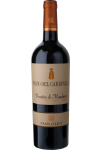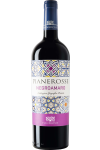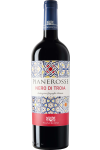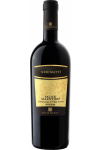- +44 (0) 20 3871 9210
- hello@northsouthwines.co.uk
- Mon - Fri: 8.30 to 5pm


Paolo Leo Millefiori Appassimento Rosso delle Venezie IGP 2023
Corvina, Merlot
Description
The wine has a lovely and intense ruby-red colour with a bouquet reminiscent of cherries, dried fruit, chocolate and prunes. On the palate it is full-bodied, soft and round, with a pleasant spiciness and an amazingly long and lingering finish.
Certifications
Alcohol
13.5%
Analytical data
dry
10.0 g/l residual sugar
5.7 g/l acidity
3.6 pH
Vineyard
The soil is predominantly calcareous-clay, with more sandy areas and others with exposed rock. This kind of soil together with the mild climate have made Salento, a sub-region of the Apulia region, a fertile soil, so that its economy is based on agriculture. The Adriatic coast is often beaten by the cold Tramontana wind, the Ionian side by the hot winds of south-African origin; this difference in temperature between the two seas gives rise to a nocturnal ventilation. This condition causes an important thermal excursion which is decisive for the final quality of the grapes and therefore of the wines.
Winemaker
Nicola Leo
Viticulture
The grapes are selected from low-yielding vineyards in province of Verona. The grapes are inter-planted and trained using the typical pergola Veronese and Guyot methods. Plant density is 4.200 vines per hectare with an average yield of no more than 1,4 kg of grapes per plant. The grapes are carefully picked by hand in early October.
Vinification
Approximately 60% of the picked grapes are placed in small wooden crates of 5 kg each. The crates are then placed in the “fruttaio,” a well aerated loft, and are left there to dry at a controlled temperature and humidity until December. During this “appassimento” the grapes will lose up to 50% of their original weight in water, thus concentrating their color, substance and aromas. The grapes which are not dried are immediately vinified. After de-stemming, the grapes are not crushed, allowing them to remain intact, reducing damage to the skins and optimizing color extraction. Fermentation takes place at a controlled temperature of 25-26°C for 8-10 days. Frequent remontage and delestage are carried out in the early stages of fermentation in order to achieve softextraction of aromas and gentle tannins. After racking, malolactic bacteria are added to induce a second fermentation. In late December the dried grapes are vinified. After de-stemming, the grapes are crushed and placed in stainless steel tanks, where selected yeasts are added. A very slow fermentation is initiated which will last approximately 30 days at a controlled temperature of 24°C. Here too frequent remontage and delestage are carried out in the early stages of fermentation in order to achieve soft extraction of aromas and gentle tannins. After racking, malolactic bacteria are added to induce a second fermentation.
Maturation
French barriques for 12 months.
Food Pairing
Roasted meat, game and aged cheeses.
Bottling
Size: 0.750l
GTIN: 08029354304352
Closure: Screw top
Packaging
Bottles per case: 6
GTIN: 08029354307360








